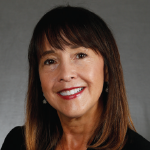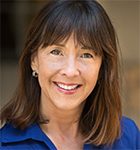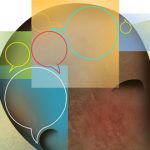Current ARHP President Afton L. Hassett, PsyD—a clinical psychologist and an associate research scientist in the Department of Anesthesiology at the University of Michigan—attended her first ACR/ARHP Annual Meeting in 1999.
Dr. Hassett submitted an abstract to the meeting describing her dissertation research exploring the role of pain and depression in rheumatoid arthritis and fibromyalgia. It was accepted, and she soon found herself among thousands of her colleagues crossing the bitterly cold and bustling streets of Boston to attend the premiere scientific meeting in rheumatology.
“I’d never seen anything like it,” she says of the meeting. “Being deeply involved in rheumatology research and seeing so many people doing the same in one place—I was like a kid in a candy store.”
For the next five years, Dr. Hassett thought everything in the ARHP revolved around its Annual Meeting. She would spend each year planning and waiting for the meeting’s arrival, because she thought it was her only opportunity to be exposed to cutting-
edge research, network with colleagues from around the world and ensure her name and research were shared with others.
After those initial years of attending the meeting, Dr. Hassett became more involved in the ARHP, and that is when she saw the organization as far more than just an Annual Meeting. “During a networking lunch chat with Karen Smarr, PhD (past ARHP president),” she says, “for the first time it became apparent to me that there is so much more to ARHP; there are boundless opportunities to learn, engage and benefit professionally and personally.”
Finding Her Place
With a new mindset, Dr. Hassett began taking advantage of all the resources and opportunities for her as a psychologist and researcher in rheumatology (see sidebar for some of Dr. Hassett’s favorite member benefits and ARHP resources).
“It is very easy to get involved,” she says. “By doing so, you meet remarkable people who become collaborators and friends. The more involved I became, the more I learned that our diverse membership allows us to draw from the best expertise across all of rheumatology. For me, that diversity was and is such an added value [of ARHP membership].”
According to Dr. Hassett, the ARHP has a way of identifying people’s unique skill sets and finding opportunities that match those skill sets. Once Dr. Hassett realized she could gain much more from her ARHP membership and how easy it is to get involved, she began accepting opportunities to gain knowledge and build relationships while giving back to the organization.
Dr. Hassett’s first foray into volunteerism was serving as an abstract reviewer for both the ACR and the ARHP, which she did over several years. In 2008, she was tapped to be the ARHP representative on the ACR Pain Management Task Force, chaired by David Borenstein, MD (former ACR president). “There was a desire to add a behavioral science perspective, and not a whole lot of pain psychologists were in membership,” she explains. “I was asked to join the task force to bring that specific perspective.”
Next, Dr. Hassett was asked to chair the Clinical Focus Course in 2010, because the ARHP wanted to develop a program highlighting pain management, and her research interests in pain would allow her to contribute greatly to the program. From there, Dr. Hassett continued to look for opportunities to participate in the ARHP and came full circle back to the Annual Meeting by joining the ARHP Annual Meeting Planning Subcommittee as the chair elect in 2011—followed by chairing that same committee for two years. Her time on the ARHP Annual Meeting Planning Subcommittee was followed by becoming the ARHP representative to the ACR Finance Committee and soon after, she was nominated to be the ARHP president elect. And in November 2016, Dr. Hassett took the gavel as the ARHP’s 48th president.
Something for Everyone
As the longest-running association serving rheumatology healthcare professionals in the U.S., the face of the ARHP looks very different today than it did when it was founded in 1965. Rheumatology has grown to include a more diverse and collaborative care team, and the ARHP has evolved from an organization serving just a few disciplines to one serving many.

Dr. Hassett
“We have grown steadily over the past 50 years—not just in the number of individual members, but in the disciplines we represent. It is quite exciting to now be able to collaborate with so many different professionals in rheumatology. The interdisciplinary nature of ARHP makes us unique,” explains Dr. Hassett.
“No matter its size, the ARHP has always provided a place for its members to establish professional relationships while gaining the skills and rheumatology knowledge that directly affect their research, patients and, really, every aspect of their profession,” she adds.
Dr. Hassett notes that ARHP members are dedicated to rheumatology and to their specific disciplines within rheumatology. “We are a passionate group and are ready to connect with our association more than ever,” she says.
‘Take the plunge, volunteer. If you do something—anything—you will feel more connected to an amazing group of professionals. But you need to take the first step: Sign up.’ —Dr. Hassett
To support that desire to connect within the organization, the ARHP is focused on ensuring there is something for every member. From journals to online education to advocacy opportunities and practice management tools, the ARHP actively works to ensure each member can find his or her network, tools and resources.
For Dr. Hassett, the ARHP has provided opportunities to present her research, learn from a diverse group of members and increase her leadership skills.
As for the many years she spent thinking of the ARHP as an Annual Meeting and only an Annual Meeting, she would say to her younger self and to other members who are considering volunteering: “Take the plunge, volunteer. If you do something—anything—you will feel more connected to an amazing group of professionals. But you need to take the first step: Sign up. If members don’t know you, they can’t give you a position on one of our many committees, subcommittees and task forces. Put yourself out there, so other volunteers can find you. Once you are connected to the volunteers, you will quickly become part of the structure and the future of ARHP.”
Sound words of advice from someone who went from an Annual Meeting attendee to ARHP president.
Learn more about resources for rheumatology health professionals.
Erin Latimer Meadows is a communications consultant and writer based in Atlanta. She is the principal consultant of Cause Collaboration LLC and works with organizations to help build their brands and meet their missions.
Afton Hassett’s Top 5
ARHP membership is a unique combination of resources, opportunities and people. Here are Dr. Hassett’s top five favorite things about being an ARHP research member.
- Journals—“This is the nature of what I do. And Arthritis & Rheumatology and Arthritis Care & Research are invaluable resources for me.”
- Diversity—“I love the people drawn to rheumatology and the unique mix of disciplines. I also appreciate the differences in each member’s work setting and geographic location.”
- Professional and personal connections—“ARHP members are great people—plain and simple. They are generous with their time and expertise, and very supportive of each other.”
- National leadership opportunities—“ARHP offers great opportunities to try your hand at national leadership. The quality of mentorship available is a major benefit.”
- ARHP staff—“The ARHP staff members are exceptional people. They guide our efforts, and are invested in the mission and in making their volunteers feel competent and supported.”

